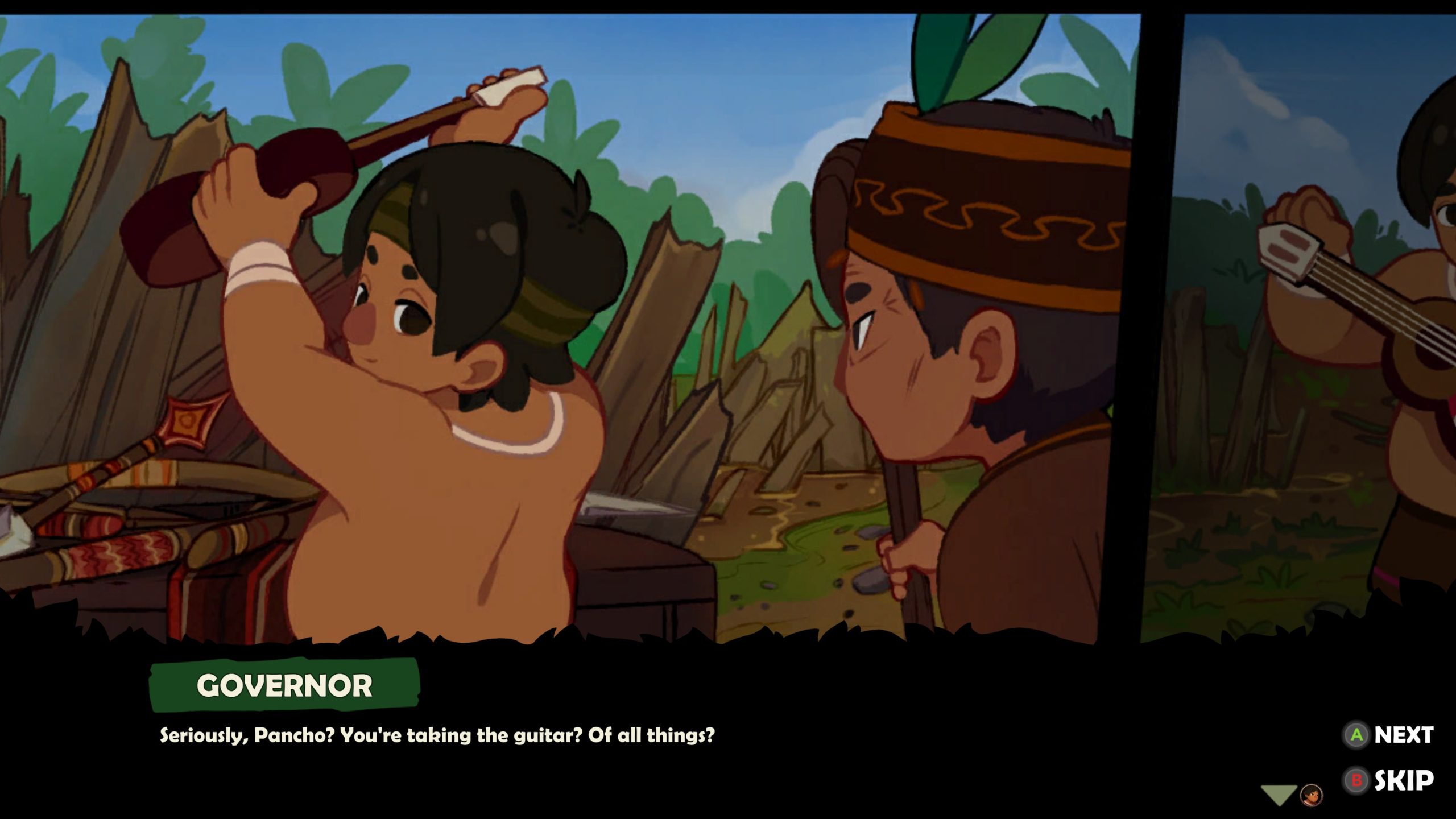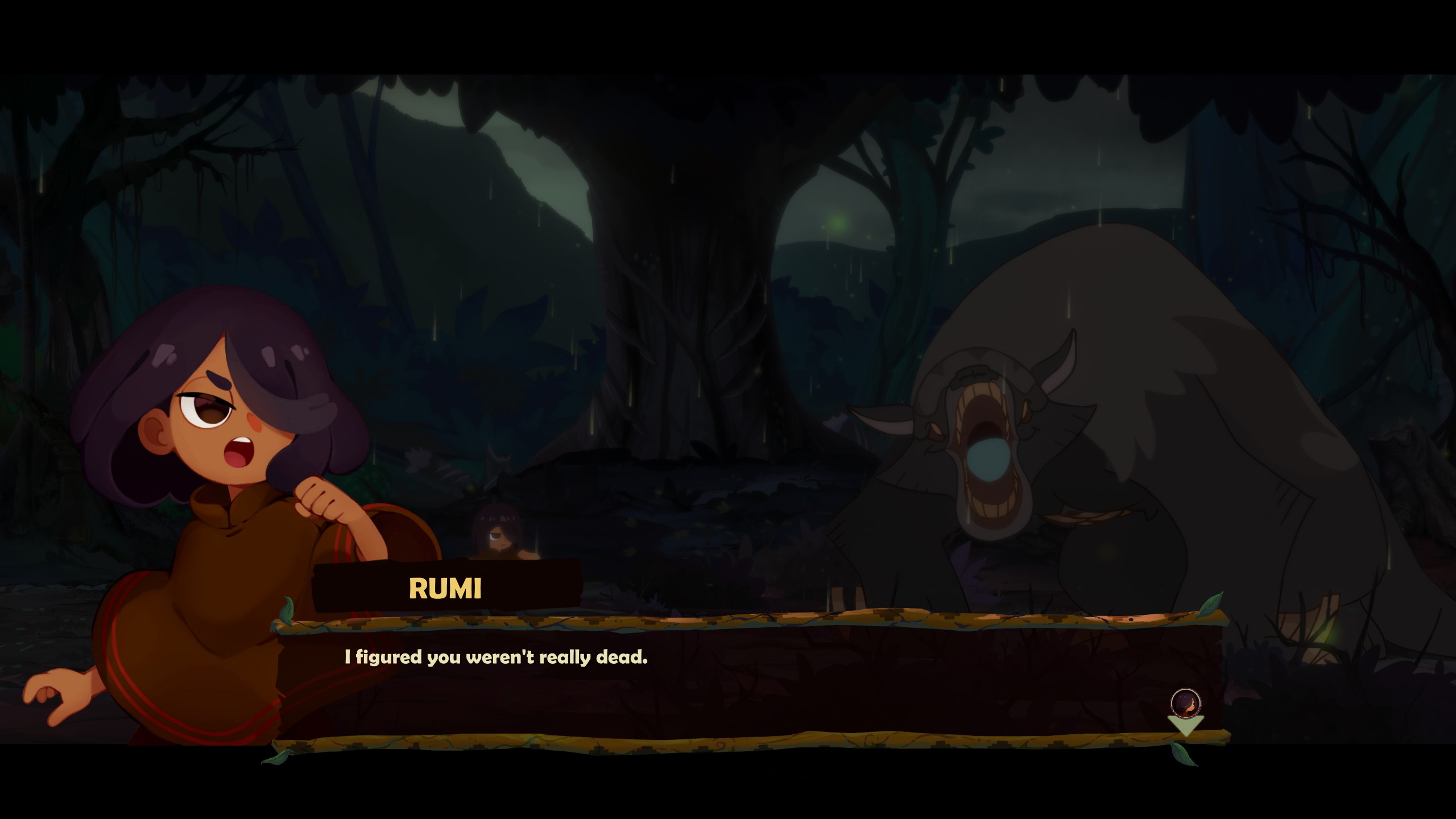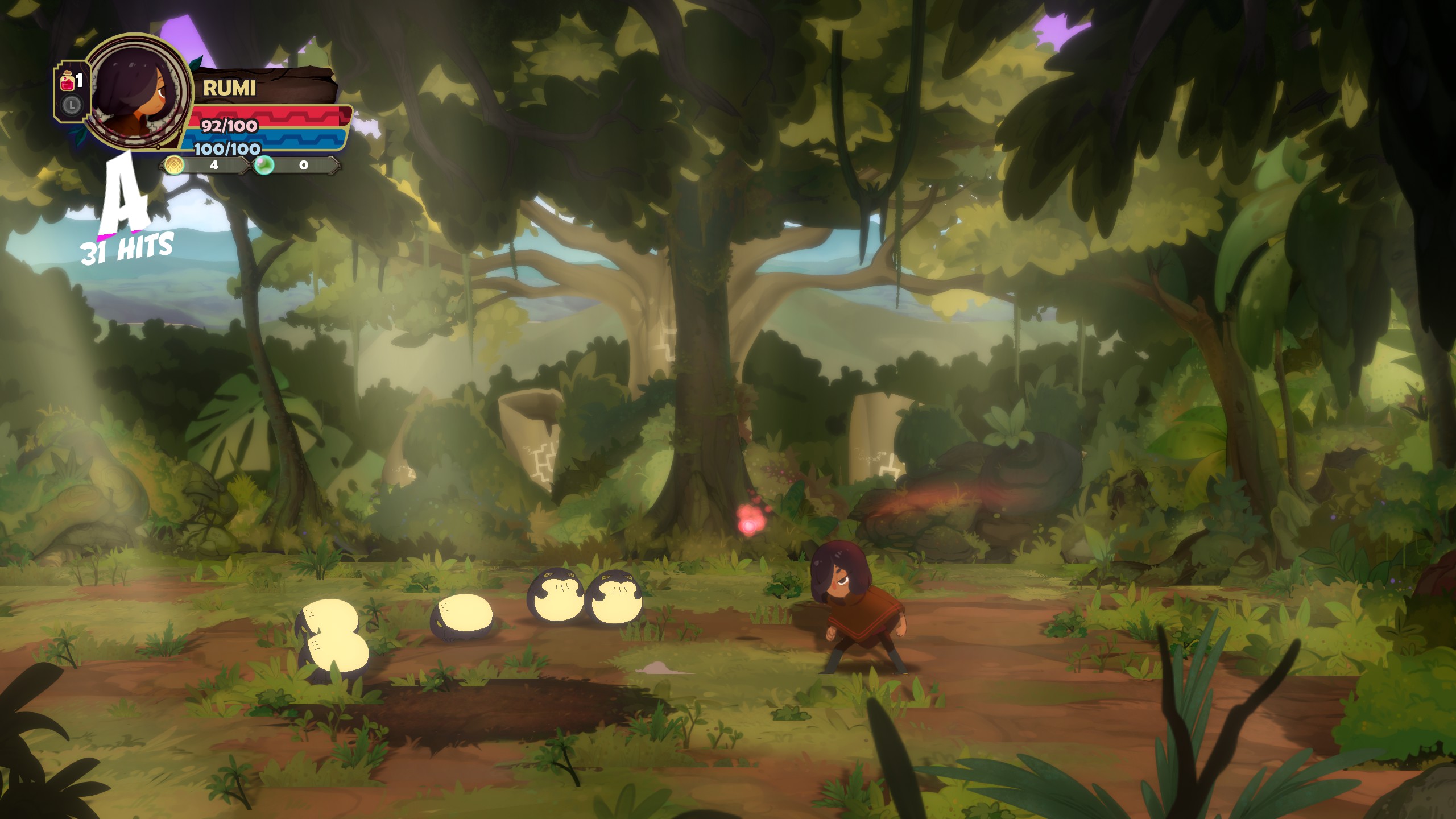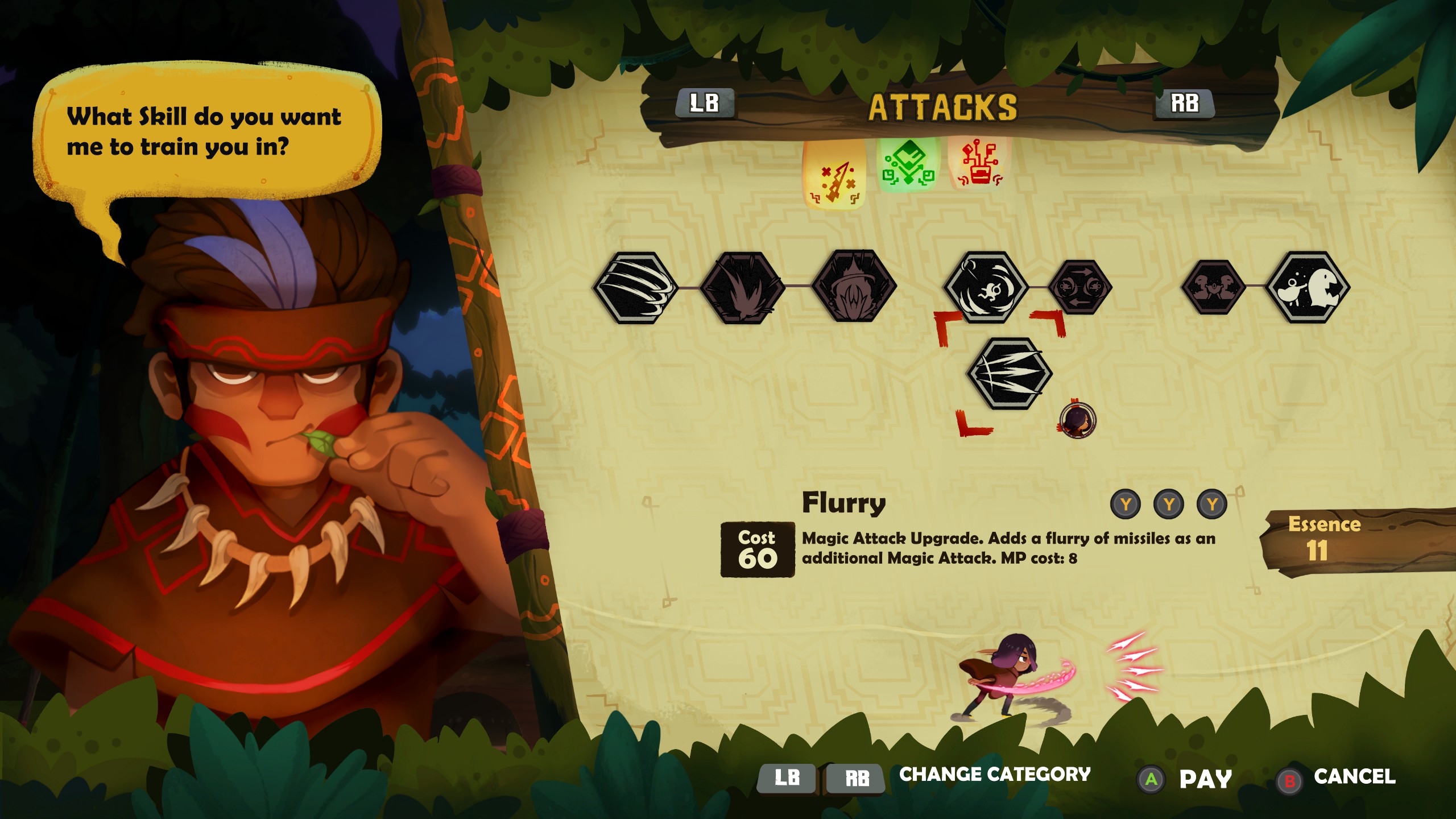Platforms:
Xbox One, PC, Nintendo Switch, Xbox Series X|S
Released:
November 2, 2021
Publisher:
Hypetrain Digital
Developer:
Leap Game Studios
Tunche is a side-scrolling roguelike beat-em-up from LEAP Game Studios, an indie developer based in Peru. The game follows a cast of five characters as they search the magic rainforest for Tunche, a powerful and terrifying being from Peruvian lore. Along with your quest, you’ll fight through rooms of enemies and gather upgrades that will bolster your abilities for the run as well as resources to improve your skills between runs back at camp.
Tunche’s greatest strengths are its art, setting, and characters. Tunche’s visual style is full of colour, with bouncy cartoon characters as your allies and enemies. Each playable character is defined by a distinct look and personality, as well as having their own reason to seek Tunche. Rumi, dressed in a poncho, has a sullen disposition that contrasts with the guitar-playing Pancho’s heartfelt optimism. Pancho has been sent to find Tunche by his tribe while Nayra took up her spear and set out for her own reasons and against the express wishes of her father. Qaru, on the other hand, has had his arms turned into feathery wings and seems to be mostly concerned with becoming fully human again. Hat Kid from A Hat in Time is also here. I have no idea why Hat Kid is here.

Each character will be fleshed out while you play them in their unique dialogue with NPCs. Pancho, for example, speaks almost exclusively in rhymes that are frequently a real stretch to qualify. These moments of dialogue are brief, mainly serving as a way to squeeze in a little character time between fight rooms. The bulk of the story is told through comic book pages that you’ll encounter during your run, filling in some backstory for the character you’re currently playing as.
The other characters you’ll encounter as you play through Tunche are less distinct. The skill trainer back at camp doesn’t have much to say beyond being grumpy and there’s little to the vendor character you’ll encounter mid-run who restocks your health potions or improves the upgrades collected during runs. A notable exception is the llama gameshow host who’ll let you bet your resources for a chance to win more by passing a deadly challenge. The llama is certainly zany if a bit one-note.
The setting of the Amazon Rainforest really shines as a source for a lot of creative ideas. The cultural history of Peru is rarely explored in video games, and seeing it from a Peruvian perspective is even rarer. Shadow of the Tomb Raider, for example, draws on languages and legends of Peru but moreso as set dressing for Lara to plunder. Because Tunche is made by a team from Peru, I’m more interested in seeing their perspective on Peruvian culture than I am in a Canadian’s perspective on it. This isn’t necessarily to say that artists can’t try to depict cultures that aren’t their own, but to acknowledge that doing so can really miss the mark—like learning about Japan from Tom Cruise’s performance in The Last Samurai.

Drawing on roots with little representation in gaming also provides a huge source of ideas that we don’t see very often. I have faced a million depictions of monsters descended from Greek and Norse mythology by this point—minotaurs, wyrms, cyclopes, giant wolves. When I encountered the first boss in Tunche, I was taken aback. In all the games I’ve played, I’ve never had to fight a giant sloth with backward feet and a chomping, toothed mouth on its stomach that belches noxious gas. This creature is Mapinguari, a legend of the Amazon rainforest traced back to Brazilian stories, and something completely new to me. Much as I’m a sucker for Greek mythology, getting to draw on different mythology provides a lot of new and interesting legends.
“It’s a combat formula mostly unchanged since Streets of Rage thirty years ago”
While Tunche’s setting is fresh, its gameplay is immediately familiar; punch, dash, jump, and uppercut enemies into the air. It’s a combat formula mostly unchanged since Streets of Rage thirty years ago. Rounding out your basic abilities is a magic attack that deals moderate damage at range—seemingly a little less than your punch in exchange for striking enemies at a distance.
These mechanics are basic, and how satisfying they feel to play comes down to their implementation in each game that uses them. When your attacks feel fluid and have a sense of weight and momentum, chaining them together as you beat down waves of enemies can be an awesome experience.
Unfortunately, that’s not how things work in Tunche. Here, every attack feels rigid, and dashing around the screen feels floaty—like hitting a ping-pong ball with a pool queue. In contrast to your airy movement is your attacks, which root you in place like a stake through the foot and immediately kill your momentum.

Your punches have a short range, so any enemy that moves backwards slightly is immune while you stand still and punch the air they used to occupy. This is particularly annoying when encountering enemies that need to be chased; in the second stage, an armored enemy needs to be hit until it drops its cover and then quickly killed as it runs away before it burrows underground. Chasing these was a pain because they move about the same speed as your character, meaning you’ll catch up and press punch, stopping on the spot and hitting the air as the enemy escapes. The game probably intends for you to hit these enemies with your ranged attack instead. The issue with that is your ranged attack feels weak and underwhelming and is even more susceptible to the game’s deceptive depth of screen.
Any attack, but ranged in particular, is easy to whiff just behind an enemy sprite. The depth you can move towards and away from the screen in Tunche’s 2D view is hard to judge and wider than it seems like it should be from looking at the stage. Coupled with movement being quick but imprecise, moving up and down the screen is likely to land you out of phase with enemies—attacks that look like they should hit miss entirely because the sprites are not in line with each other despite appearances.
One of the most disappointing things about Tunche’s combat is how every character feels the same to play. These characters are all visually distinct and given their own personality and reasoning for their quest, but they play like stock reskins of each other with their basic attacks.

The upgrade system feels the flattest. Progression comes in two flavours; skill unlocks and improvements for the upgrades collected during runs. The skills are expensive and there aren’t many of them, with some of what’s locked off looking more like a default ability that should be accessible from the start. For example, I had 11 upgrade points and once I got to 60 I could pay to unlock a three-button tap combo. The time it takes to unlock skills feels worse when the skills themselves don’t seem exciting, and both make the fact that combat is limited and repetitive even worse.
“When you’re only given three moves, spamming them is about all you can do.”
The upgrade system also ties into the game’s style meter, which gauges your performance in a fight by landing hits. The problem is that the meter strongly preferences using a variety of attacks—I was landing punches on an enemy without getting hit and watching the meter go down for my lack of creativity—but it’s impossible to satisfy maintaining variety when I don’t have a variety of options actually available to me. When you’re only given three moves, spamming them is about all you can do.
Ultimately, I agree with the style meter; I would also like to see more interesting combat.
Certain upgrades you pick up through your run in Tunche rely on having your style meter at an A or above. These upgrades didn’t feel all that meaningful though because I was able to get through fights without hitting that A rank. If you can maintain an A rank through a fight, then you probably don’t need any other benefits to keep you there. The upgrades I encountered in my runs at least appeared to be minor bonuses for when you’re already winning rather than anything that fundamentally changes how Tunche is played. This lack of meaningful progression or variety really contrasts with something like Hades where you can create many different builds that can feel very different to play. Tunche doesn’t seem to have builds; you’re fully upgraded Rumi would be the same as any other, leaving no room for expression or experimentation.
5
Average
Positive:
- Appealing art style with some interesting enemy designs.
- Colourful cast of characters with their own reasons to seek Tunche
- Drawing inspiration from a culture rarely shown in gaming feels fresh and interesting.
Negative:
- Depth is difficult to judge with the game's 2.5D layout.
- Attacking makes you stand still, immediately losing all momentum.
- Minimal combat abilities lead to combat feeling very repetitive.
- Progression is limited and offers no interesting build choices.
Tunche combines familiar mechanics with a setting that is rarely represented in video games. This keeps the game’s visual design fresh, but the combat is more than familiar and not up to the standard set by other games in these genres. Tunche can’t scratch the side-scrolling beat-em-up action of River City Girls or the honed roguelike structure of Hades. Unforturantely, this means the game’s charming art and characters are at battle with lackluster gameplay.




